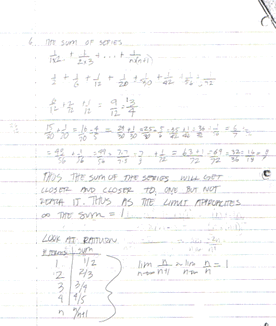
Discussion: this is a good beginning problem to illustrate how to approach a situation which can be parameterized by positive integers. It is also a good demonstation of the virtue of "getting one's hands dirty." By working out several cases, that is, computing the partial sums, a pattern begins to emerge which is easily recognized by the fourth or fifth term. This student pursued this strategy and comes to the correct conclusion about the partial sums and the sum of the series - that it is 1. The problem as shown is not complete since no effort was made to demonstrate that the pattern, indeed, holds for all partial sums.
My written response to this student was as follows: Good investigation to see the pattern for partial sums and to recognize that if this pattern persists then the infinite series has sum 1. Can you prove tha the n th partial sum is n/(n+1)? Try using induction.
Click the image to view a magnificationClick
